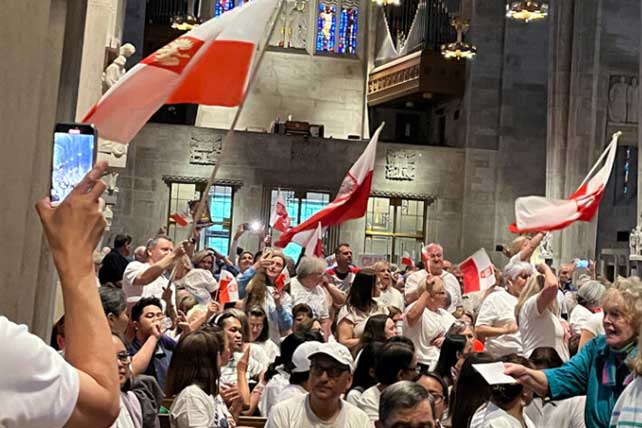Opposition to parish closures is about “tradition and memories and the incarnational presence of Christ in the community,” said Susan B. Reynolds, assistant professor of Catholic studies at Emory University’s Candler School of Theology, but it can become a “proxy battle, kind of a referendum on the authority of the church itself.”
The percentage of Americans identifying as Catholic has dropped from 24% in 2007 to 20% in 2023, according to Pew Research Center. In a PRRI poll, 45% of former Catholics cited the clergy sexual abuse crisis as a reason for leaving. Among people of any faith who no longer attend, 47% cited negative teachings about or treatment of gay and lesbian people.

Community members gathered for a discussion on the potential closure of churches in the Baltimore Archdiocese. RNS photo by Aleja Hertzler-McCain
In the new parishes that the archdiocese envisions, parishes housed in traditional churches will draw more than 500 people to weekend Masses. A few smaller parishes will meet in nontraditional sites, such as strip malls.
Reynolds said that, while these models prioritize financial stability through large parishes, the archdiocese is losing out on the value of small communities, especially in the urban context. “You cease to be present among the poorest of the poor in a city, on the margins, among the most vulnerable,” she said.
“These are some of the most powerful witnesses to the gospel that we have. These are spaces of intimacy and love that are really irreplaceable,” Reynolds added. “That reality of communion, of solidarity, of being the body of Christ is so alive in a small community.”
Reynolds predicted Baltimore’s closures will have long-term impacts, noting that in Boston, where between a fourth and a fifth of the city’s parishes were closed in 2004, the first large-scale closures in the current era, “the legacy of those closures is still really deeply felt by Catholics there.”
Boston’s closures inspired fierce resistance, including multiple sit-ins in closed parishes. At St. Frances Xavier Cabrini, parishioners staged a 24/7 sit-in for more than 11 years.

Baltimore parishioner Sam Moxley is worried about the potential closure of churches in his archdiocese and the impact it could have on the community. RNS photo by Aleja Hertzler-McCain
One lesson from Boston, Reynolds said, is that the archdiocese must invest in helping the combined parishes build a new sense of identity. Parishioners are coming from a place of woundedness, she said, and may be lack the energy to rebuild.
Many Baltimore Catholics expressed concern that ministry to poor and vulnerable people will vanish with their parish. Baltimore resident Sam Moxley told Religion News Service he drives past multiple Catholic churches to go to St. Joseph’s Monastery because “the gospel gets preached from the pulpit, but we preach Jesus Christ on the streets.” He said he worries about leaving the community around the parish behind if the proposed closure goes through.
Baltimore Auxiliary Bishop Bruce A. Lewandowski said at the April 30 session that, with fewer buildings to maintain, the archdiocese could focus more on ministry and outreach, but specifics about such programs will only come in a future implementation phase.
Immigrant Catholics shared deep pain at the cathedral at the thought of parish closures. One parishioner, from Our Lady of Victory, on the far southwest edge of Baltimore, said that many of the parish’s members had fled Myanmar’s military dictatorship.
“When we were strangers in a new land, there was only one place that felt like home,” the parishioner said. “Losing our community home feels especially cruel and traumatic.”
Debra Tagle, who attends the Shrine of the Sacred Heart, told RNS that the Filipino community at her parish had shown up with banners and chants because, as immigrants, the shrine “is the only place where we feel so welcome, and this is our home.”
At a separate Spanish-language feedback session at Our Lady of Fatima in east Baltimore on April 29, it was clear the parish closures would hit hard for Latinos as well.
Lewandowski told Latino Catholics that, in 2022, out of 850 baptisms in the city, 450 occurred in just four predominantly Hispanic parishes. Yet, two of those four parishes are slated to close.

